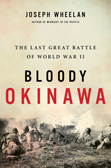 It was called Operation Iceberg, and it was the Pacific war’s biggest and bloodiest island battle, lasting from April 1 until June 22, 1945. It was called Operation Iceberg, and it was the Pacific war’s biggest and bloodiest island battle, lasting from April 1 until June 22, 1945.
More than a quarter of a million people died: up to 130,000 Japanese soldiers and auxiliaries; 12,000 U.S. servicemen; and a shocking 120,000 Okinawa civilians — the most civilian deaths of any Pacific war battle.
The 82-day battle was the final clash between a modern industrial power, the United States, and Japan, an industrial power infused with ancient samurai traditions regarding loyalty, self-sacrifice, and death.
A hallmark of the battle was the 10 mass attacks by kamikazes targeting the Fifth Fleet off the Okinawa coast. Japanese pilots sank 36 warships and damaged 368 others. The kamikaze attack was a terrifying new weapon, one born of desperation during World War II’s last months.
On Easter Sunday, April 1, 1945, more than 184,000 U.S. troops began landing on the only Japanese home soil invaded during the Pacific war. Just 350 miles from mainland Japan, Okinawa was to serve as a forward Allied base for Japan’s invasion in the fall of 1945.
Nearly 140,000 Japanese and auxiliary soldiers watched the American landings, mounting only token opposition. It was part of a new Japanese attritional strategy that began in the fall of 1944; its purpose was to prolong every battle and inflict maximum casualties.
The hope was that heavy losses would convince America to drop its demand for unconditional surrender and to instead negotiate a peace.
The Japanese defenders waited inside their hollowed-out, fortified hills and ridges for the Americans to come to them. On April 4, the Americans reached the Japanese outer defenses on southern Okinawa, and were met by a hurricane of gunfire. Under constant fire and in the rain and the mud, the Americans battered the defenders with artillery, aerial bombing, naval gunfire, and every infantry tool.
To maximize American casualties, Japanese planes of all types crashed and bombed U.S. ships. The attacks were terrifyingly effective, killing nearly 5,000 U.S. seamen.
When the battle ended in June 1945, about 125,000 enemy soldiers lay dead — along with 7,500 US ground troops. Tragically, at least 120,000 Okinawa civilians perished while trapped between the armies. The brutal campaign persuaded US leaders to drop the atomic bomb instead of invading Japan.
Bloody Okinawa utilizes graphic accounts by US combatants, Okinawa civilians, and Japanese survivors to endow the narrative of World War II’s last great battle with a strong human dimension.
Available at these on-line booksellers:
|

![]()